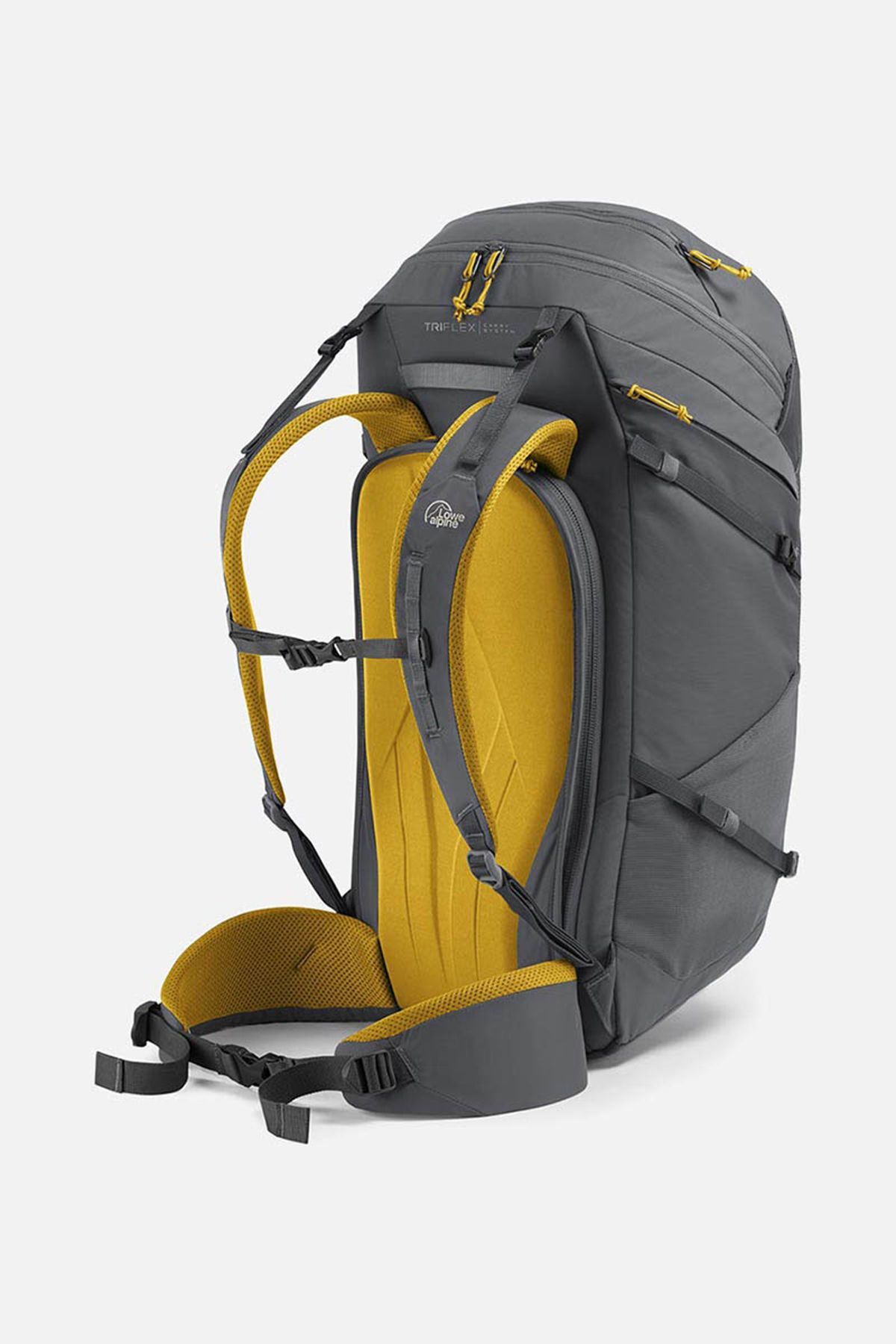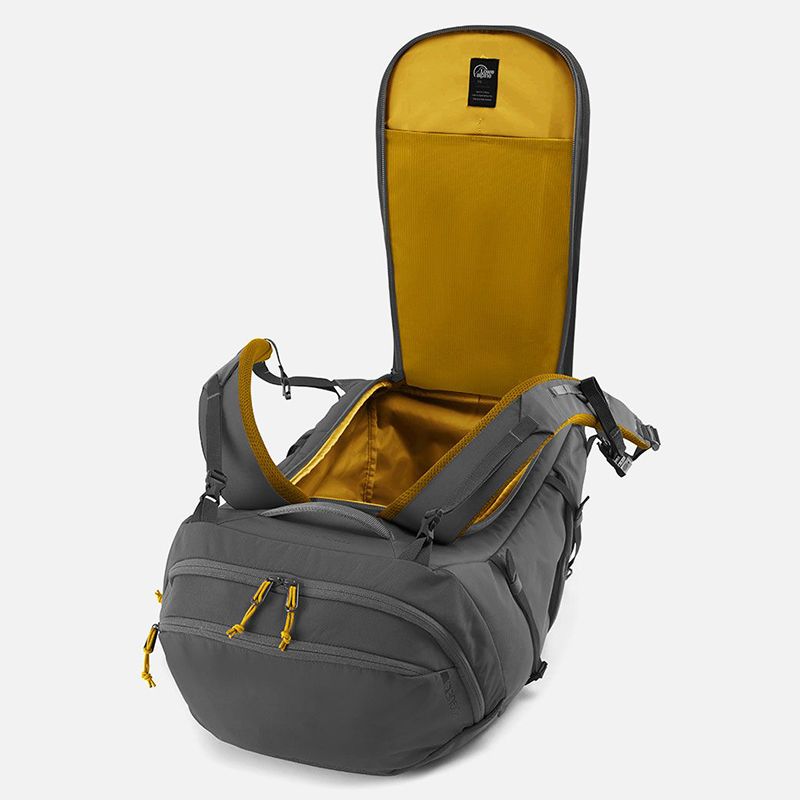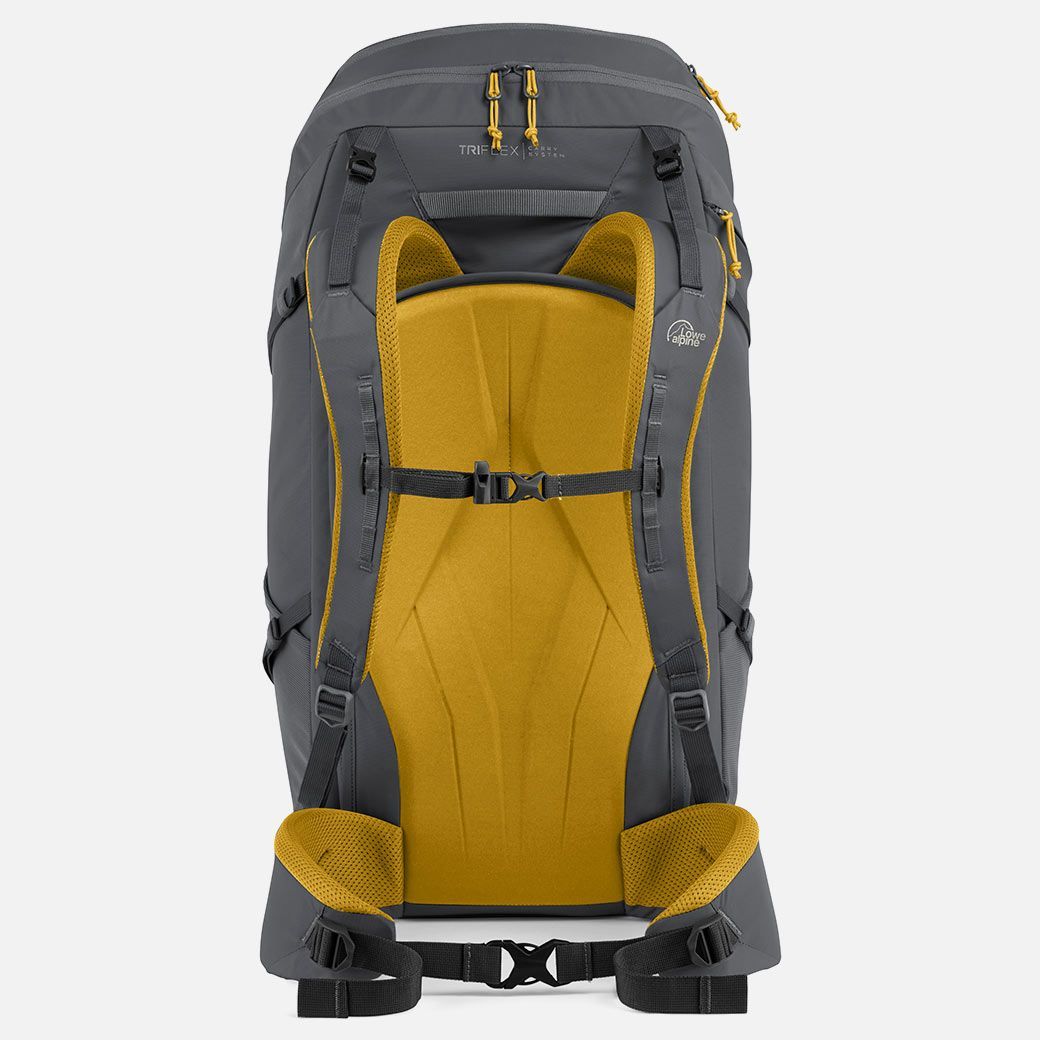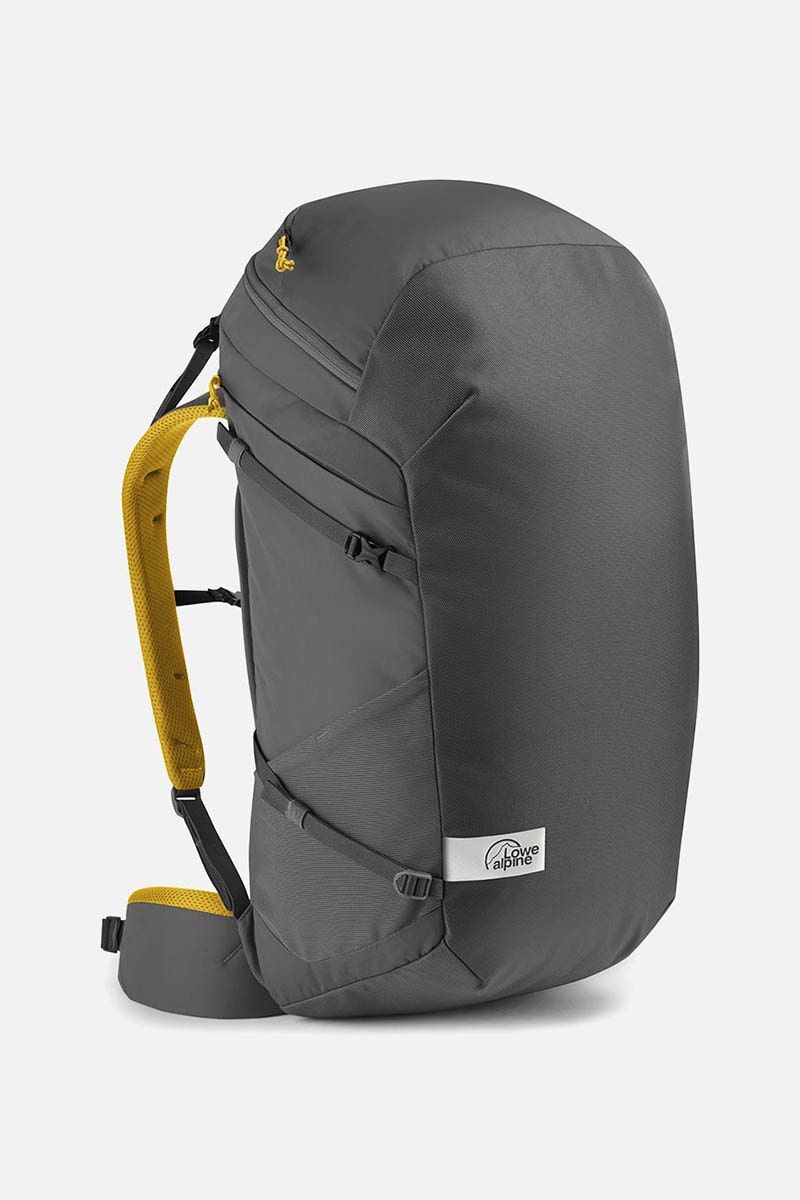
Lowe Alpine Rogue 48
29/3/2021
Last year Lowe Alpine introduced a new range of cragging-specific backpacks and I have been trying out the largest capacity version–the Rogue 48. If you don't want to read all the details below, the summary is I like it. A lot.
The Rogue is described by Lowe Alpine as their 'trad' climbing pack, versus the Outcast 44, which is designated as the 'sport climbing' model. In reality, the two packs share a harness system and overall design philosophy—there is little reason to choose one over the other based on these use designations, but rather on the capacity and particular features. We, the user, and Lowe Alpine themselves know that the use cases for trad climbing versus sport climbing are more about similarities than differences, but this 'trad' designation for the higher volume pack reflects the potential extra space required for a rack.
 The Outcast has a very wide posterior 'book-style' opening to provide instantaneous access to all your gear in a similar way to other popular cragging bags like the Metolius Cragstation. The Rogue differs in that it has traditional top-loading access like the packs of yore, while adding in the zip-opening back panel that has become de jour on avalanche/ski packs. Essentially, this is another way of giving quick access to the full pack contents, but differs by which side of the pack you place on the ground/in the snow/in the dirt. The sport climbing model goes harness side down, zip access to the back panel means you place a pack down harness side up. This came about in snow sports packs for obvious reasons, you don't want the side that goes against your back picking up snow—it just makes sense to keep the harness away from the ground and integrate an opening on that side. For the Rogue, that means the (very nice) back panel stays out of the thick dust and guano found on the ground on my trad climbing trips to the, er... Cave. Whether trad climbers or sport climbers (need we choose to be one or t'other?) care more about keeping their backs clean of dirt I'll not make comment. The point in explaining this difference is you'll probably know which you might prefer, as this is the primary difference other than the four litre capacity (in case you haven't clicked, the 48 and 44 in the names designate the capacity). I favour larger capacity bags for climbing because I always seem to want an extra insulation layer and pair of climbing shoes on my cragging adventures, and don't mind carrying them. So, while 4L isn't a huge difference in capacity, 48L was closer to the 55L pack I was using previous to the Rogue. I wasn't originally compelled toward either of the particular opening functions, but now that I've used it, I'm very happy with the back panel opening on the Rogue. A friend has the Outcast and is equally-satisfied, but I know people can be particular about these things.
The Outcast has a very wide posterior 'book-style' opening to provide instantaneous access to all your gear in a similar way to other popular cragging bags like the Metolius Cragstation. The Rogue differs in that it has traditional top-loading access like the packs of yore, while adding in the zip-opening back panel that has become de jour on avalanche/ski packs. Essentially, this is another way of giving quick access to the full pack contents, but differs by which side of the pack you place on the ground/in the snow/in the dirt. The sport climbing model goes harness side down, zip access to the back panel means you place a pack down harness side up. This came about in snow sports packs for obvious reasons, you don't want the side that goes against your back picking up snow—it just makes sense to keep the harness away from the ground and integrate an opening on that side. For the Rogue, that means the (very nice) back panel stays out of the thick dust and guano found on the ground on my trad climbing trips to the, er... Cave. Whether trad climbers or sport climbers (need we choose to be one or t'other?) care more about keeping their backs clean of dirt I'll not make comment. The point in explaining this difference is you'll probably know which you might prefer, as this is the primary difference other than the four litre capacity (in case you haven't clicked, the 48 and 44 in the names designate the capacity). I favour larger capacity bags for climbing because I always seem to want an extra insulation layer and pair of climbing shoes on my cragging adventures, and don't mind carrying them. So, while 4L isn't a huge difference in capacity, 48L was closer to the 55L pack I was using previous to the Rogue. I wasn't originally compelled toward either of the particular opening functions, but now that I've used it, I'm very happy with the back panel opening on the Rogue. A friend has the Outcast and is equally-satisfied, but I know people can be particular about these things.
 The marketing for these packs from Lowe Alpine makes particular note of the 'TriFlex Carry System' on both. This is, on face value, an internal aluminium frame, moulded back panel, shoulder straps, a waist belt and sternum belt—all fairly obligatory. I was inclined to dismiss the special name as marketing hype and move on. But I have to admit that the Rogue is more comfortable to wear and carry gear than I expected. I've been carrying about the same amount of gear to the crag for 20 years and across the different packs I've used the experience has always been tolerable, but the Rogue just makes it seem lighter and less of a burden. I don't really know how it achieves this, but I'm impressed nonetheless. Again, my friend with the Outcast has reported the same thing and has previously suffered back trouble, so I don't think it is just me.
The marketing for these packs from Lowe Alpine makes particular note of the 'TriFlex Carry System' on both. This is, on face value, an internal aluminium frame, moulded back panel, shoulder straps, a waist belt and sternum belt—all fairly obligatory. I was inclined to dismiss the special name as marketing hype and move on. But I have to admit that the Rogue is more comfortable to wear and carry gear than I expected. I've been carrying about the same amount of gear to the crag for 20 years and across the different packs I've used the experience has always been tolerable, but the Rogue just makes it seem lighter and less of a burden. I don't really know how it achieves this, but I'm impressed nonetheless. Again, my friend with the Outcast has reported the same thing and has previously suffered back trouble, so I don't think it is just me.
In terms of other features, the Rogue is fairly simple, but mostly very functional. There is a small external top pocket for quick access items, matched by a larger internal zip pocket on the underside of the 'lid'. I call it a lid, but it isn't in the traditional sense, this is just the top part of the pack that folds over when using the top access method. These two compartments provide some gear separation, I can keep my wallet, phone, snacks and keys in one, while nasty liquid chalk, finger tape, first aid etc can go in the other. There is also a sleeve for a hydration bladder, but other than that the internal area is simply a cavernous space. On the exterior is a zip side pocket which is great for a water bottle and elastic mesh sleeves on the lower parts of the sides which are handy for things like banana peels or avocado skins that need to stay out of general population. The Outcast has a few more bells and whistles in this respect, with an internal mesh divider, included rope tarp, internal gear loops and externally a designated clip stick pocket, if you need that sort of thing. This perhaps makes the Outcast a bit more of a climbing-specific design, while I feel that the Rogue would be quite functional for general use as an all-rounder if the capacity was right for that activity.
There is one feature that Lowe Alpine enthuse about but I haven't really got along with, that is the rope-carrying system integrated into the harness. Essentially, you can lay a rope over the back of your shoulders and on top of the harness straps. I've been doing this already for years, the rope is generally held in place between your back and and the top of the pack, but more athletic scrambling can cause it to eventually drift off to one side or the other. What Lowe Alpine have done is make the top retention straps for the shoulder straps unbuckleable with quick release clips, so that these can go around the rope and hold it in place. In theory, this seems like a great improvement on my existing method. In practice, I found putting a rope in this spot before hoisting the pack onto my shoulders would leave the rope uncomfortably jammed too low down my back. Loosening the retention straps creates a bit more space for the rope, but does leave the top of the pack hanging back further away from my back than I usually like to have it. Of course, you can put the rope there after the pack is on already, but in this case my shoulders aren't flexible enough to reach the clips and undo then redo them around the rope with everything in position behind my back. While my shoulder inflexibility is probably near the toe of the bell curve, I think for most people this would still be a 'phone a friend' arrangement. This isn't really a negative, because I can still put the rope there as I have done on other packs with the same limitations, and if I want it to be more secure for an extended or treacherous approach I can still use the system as intended with the help of a climbing partner. But it isn't quite a game-changing 'why has nobody else thought of that?' feature either.
 Durability-wise, these packs don't have the same sense of bomb-proof indestructibility you get from something like The North Face Cinder. But those models' thick 1000D PU-coated nylon build is best-in-class and allows them to be used as small-scale haul bags (and I have) and this comes with a bit of added weight. The Cinder 55 is a good half-kilo heavier than the Rogue (Cinder 55 1841g, Rogue 48 1365g) and while it has a stated higher capacity, I think the difference in design means I can carry about as much in/on the Rogue as I can the Cinder. The top-loading design of the Cinder means the more you attempt to overstuff it, the less you can fit in the lid pockets, which can be a frustrating end-of-packing experience. By contrast, I pack the Rogue mostly through the large back panel opening, which allows for easier strategic packing, followed by a last-ditch 'stuff compressible gear in the top'. Even after that, there are still the external stretch pockets and compression straps if you are really stuck for space. The Cinder, being a snag-free, hauling-friendly design eschews any exterior compartments or sleeves besides the zip top pocket. Neither pack is touted as a particularly lightweight option, but this difference in weight is considerable. It would matter less if the Rogue was so light as to need special treatment, but the 840D ballistic nylon on the posterior (the bit that meets the ground) should stand up to plenty of abuse. I've seen no sign of wear on mine, so durability is not a concern.
Durability-wise, these packs don't have the same sense of bomb-proof indestructibility you get from something like The North Face Cinder. But those models' thick 1000D PU-coated nylon build is best-in-class and allows them to be used as small-scale haul bags (and I have) and this comes with a bit of added weight. The Cinder 55 is a good half-kilo heavier than the Rogue (Cinder 55 1841g, Rogue 48 1365g) and while it has a stated higher capacity, I think the difference in design means I can carry about as much in/on the Rogue as I can the Cinder. The top-loading design of the Cinder means the more you attempt to overstuff it, the less you can fit in the lid pockets, which can be a frustrating end-of-packing experience. By contrast, I pack the Rogue mostly through the large back panel opening, which allows for easier strategic packing, followed by a last-ditch 'stuff compressible gear in the top'. Even after that, there are still the external stretch pockets and compression straps if you are really stuck for space. The Cinder, being a snag-free, hauling-friendly design eschews any exterior compartments or sleeves besides the zip top pocket. Neither pack is touted as a particularly lightweight option, but this difference in weight is considerable. It would matter less if the Rogue was so light as to need special treatment, but the 840D ballistic nylon on the posterior (the bit that meets the ground) should stand up to plenty of abuse. I've seen no sign of wear on mine, so durability is not a concern.
And in terms of the weight, I'll just say this. For the intended use of this pack, the weight is completely reasonable, I'd even say it feels light to me. To qualify that statement, I was happy for years carrying a higher capacity pack than needed to the crag. Most of the crag approaches I do aren't long enough to be obsessing over weight, and as a photographer of climbing I am generally carrying extra weight compared to most people anyway. So, if you are one of those people who always want to have the lightest possible load and obsess over every gram at every opportunity, you may decide otherwise. I'm way more excited about the dual-access design eliminating the need for rummaging around inside the dark recesses of a top-loading pack looking for my nut tool or ascender than I care about a few hundred grams either way.

My only real gripe with this pack, and I'm being really nit-picky here (but that's what I'm supposed to do, right?), is the zips. I mostly think a zip is a zip is a zip—so long as they don't break I don't pay them any attention. But I also expect to be able to just grab a zip pull and for it to open. With the Rogue, I've found that for the top opening and top pocket zips this is a two-handed operation. This isn't necessarily because of the zips themselves, though they are of a slightly finer-toothed variety than you might expect on a pack like this. It is mostly because all the structure of the pack is in the back panel area, everything posterior of that is simply shaped fabric. This fabric is tough, but it isn't stiff and thus doesn't hold its shape unless packed full already. This means that if you grab a zip and pull, especially when the pack is empty, you need to hold the surrounding area to get the zip to slide, otherwise it just kind of pulls the whole area around the zip or the zipper length folds on itself and thereby doesn't slide easily. The zip around the back panel is the same gauge and works very well, because the area is held rigid by the stiffened back panel and facilitates the zipper to slide easily. On a smaller bag, you have this issue anyway, because the zip generally has more resistance to sliding than the weight of the bag, so you need to hold the bag down with one hand and slide the zipper with the other. But this pack is big enough that I have the expectation that I wouldn't need to do that.
I'm not an expert on these things, but I think if the fabric were stiffer, or the zip was a larger gauge with bigger teeth and a corresponding greater linear stiffness through its length, then it would stay in shape and slide more easily or at least more often with a one-handed pull. Of course, both of these differences would add more weight and I have to say, this is a pretty minor inconvenience in the grand scheme of what this pack offers. But from my observation, the Outcast has a bit more structure to the fabric—as the book-opening design means it needs to hold its shape a bit more to work properly—as well as a bigger gauge zip (again, probably because that type of design requires a sturdier zip as it is placed under greater and more eccentric strain) and the zippers on this avoid the minor nuisance I'm talking about and run very freely. It is likely that this zipper–fabric interface was a design choice rather than an oversight, as in any design compromises have to be made for one rationale or another. For instance, adding structure to the posterior of the Rogue would potentially go some way to solving this minor issue, but it would also add weight and mean that when the pack is empty it would no longer go completely flat for storage, which is something some other reviewer might complain about if it weren't the case. I can live with the choice made here and the very fact that this is what I have to complain about shows how good the pack is.
Overall, I think the Rogue is an excellent pack with a well-thought-out set of features. It is more comfortable carrying my gear to the crag and it is easier to pack that gear into it and access the gear while at the crag, which makes it easily the best cragging pack I've ever used.
Lowe Alpine Rogue 48 - $279.95
4.5 stars
-Tom Hoyle
